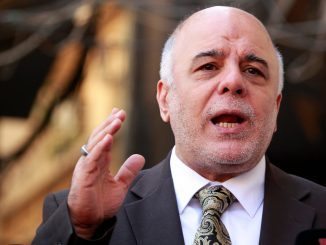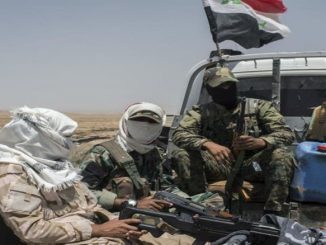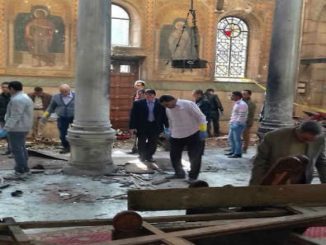
US-backed Iraqi forces built a new bridge over the Tigris river south of Mosul after flooding had blocked all crossing points, opening an escape route for families fleeing fighting between government forces and Islamic State.
At the height of its power two years ago, Islamic State ruled over millions of people in territory running from northern Syria through towns and villages along the Tigris and Euphrates river valleys to the outskirts of Baghdad in Iraq.
However, ISIS’s territory is shrinking rapidly since last year as the US-led coalition, the Turkish-backed forces, and the Russian-backed Assad regime forces have fierce fights against its forces in both Syria and Iraq.
The United States is providing air and ground support to Iraqi and Kurdish forces trying to dislodge the hardline group from Mosul.
Iraqi forces captured the eastern side of Mosul in January after 100 days of fighting and launched their attack on the districts that lie west of the Tigris river on Feb. 19.
Islamic State militants retreated across the Tigris river to western districts of Mosul, where they are using mortars, sniper fire, booby traps and suicide car bombs to fight the offensive carried out by a 100,000-strong force made up of Iraqi armed forces, regional Kurdish peshmerga fighters, and Iranian-trained Shi’ite paramilitary groups.
ISIS militants had grave losses in western Mosul despite their fierce resistance and were not able to advance rapidly despite using extreme force and fire power.
This battle had a grave effect on the civilians in Mosul, as more than 320,000 civilians have been displaced since the military operations started, and were accommodated in refugee camps that are crumbling by the newcomers and lack the basic living conditions.
The civilians escaped death and suffer that increased since the military operations started, as thousands of civilians have been killed and injured by both ISIS and the US coalition.
Since October 2016, when the Mosul campaign began, more than 6,000 wounded – over half of them civilians – have been sent to hospitals in Erbil and liberated eastern Mosul, as well as to field hospitals around the city. In one incident, more than 200 civilians were killed in an alleged US airstrike on west Mosul.
New bridges built
On Friday, the army dismantled makeshift bridges linking the two parts of Mosul due to heavy rain, forcing residents leaving Iraq’s second-largest city to use small boats.
The city’s permanent bridges have been largely destroyed during a six-month military campaign to seize back Mosul from the group, which overran it in 2014.
Long queues formed at the new bridge on Tuesday with families crossing in public buses, trucks and taxis.
Fighting continued in the Old City where heavy smoke could be seen from the area of the Grand al-Nuri Mosque, from where Islamic State leader Abu Bakr al-Baghdadi declared a “caliphate” spanning parts of Iraq and Syria.
Aircraft, helicopter and artillery opened fire, while gunfire could also be heard at several positions of Iraq’s federal police near the Old City.
“They (Islamic State militants) carry out attacks on our defensive lines, but each time we repel them and they run away, leaving bodies of their dead fighters behind,” Lieutenant Colonel Hussein Lazim Zghayer said of the force’s 9th division.
“Minutes ago, they launched an attack and we responded by shelling them with mortar rounds, killing two of them and their bodies were left in front of our defensive lines,” he said.
More than 300.000 civilians flee
Aid shipments also resumed to the Hammam al-Alil camp, southwest of Mosul, the main arrival point for people fleeing the fighting.
Deliveries from Erbil, located some 80 km (50 miles) east in peaceful Iraqi Kurdistan, where aid agencies are based, had stopped due to the flooding.
“Everything is back to normal,” said a spokeswoman for the U.N. refugee agency UNHCR.
Some 20,000 people have escaped from Mosul in the past four days, fewer than before due to the lack of transport, the UNHCR said in a report. Almost 330,000 people have fled Mosul since Iraq started an operation to expel Islamic State in October.
They were some of the around 400,000 people still in western Mosul where military forces are trying to dislodge the militants from the Old City.
“Civilians in Mosul face incredible, terrifying risks,” said Lise Grande, UN humanitarian coordinator for Iraq.
“They are being shot at, there are artillery barrages, families are running out of supplies, medicines are scarce and water is cut off.”
“Mosul has pushed us to our operational limits,” Grande said. At least 493,000 people have fled Mosul, leaving almost everything behind, she added.
The end of the battle for Mosul will also leave Iraq struggling with thorny political issues including control of recaptured territory in the north that is claimed by both the country’s autonomous Kurdish region and its federal government.
And Iraq will still be contending with the effects of the war — citizens killed, wounded or missing, hundreds of thousands displaced, houses, shops, and infrastructure wrecked, children years behind in school — for years to come.



